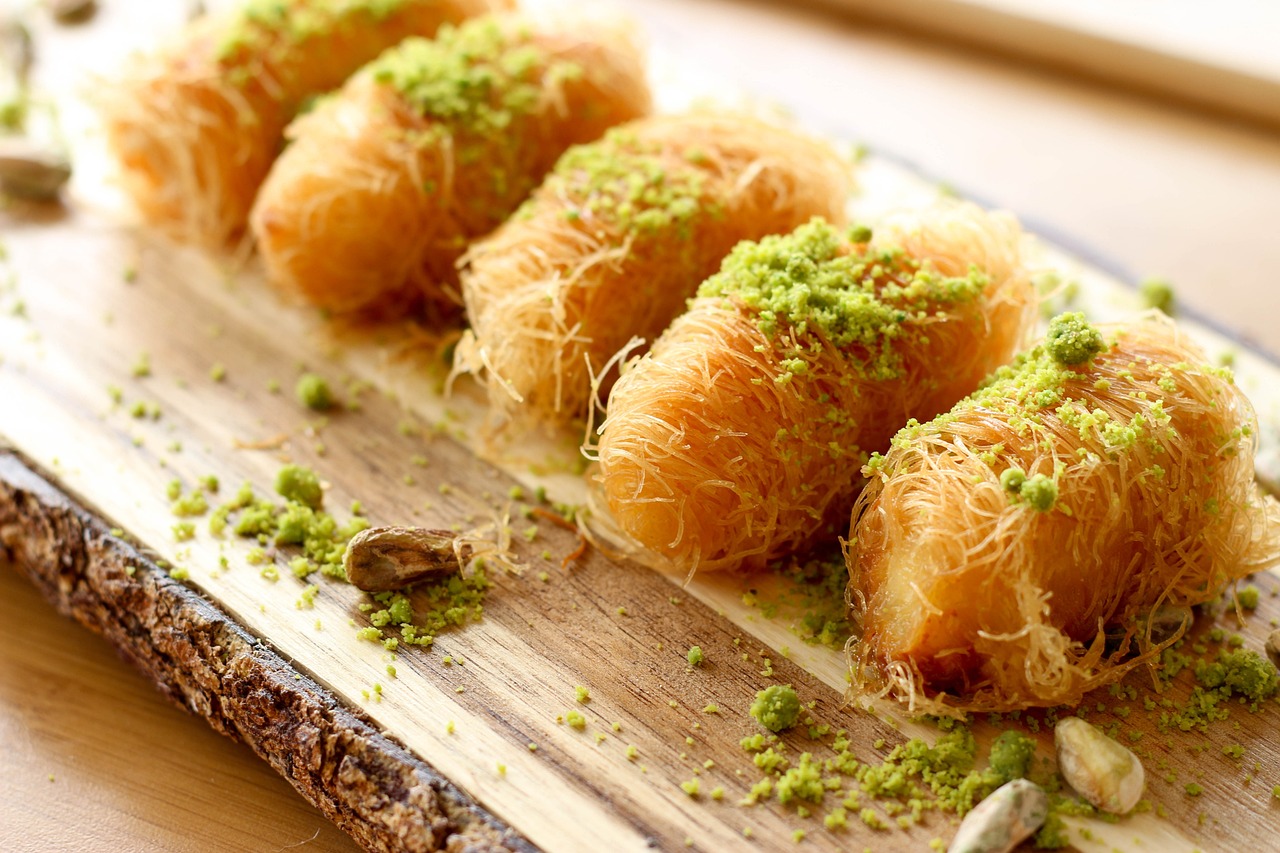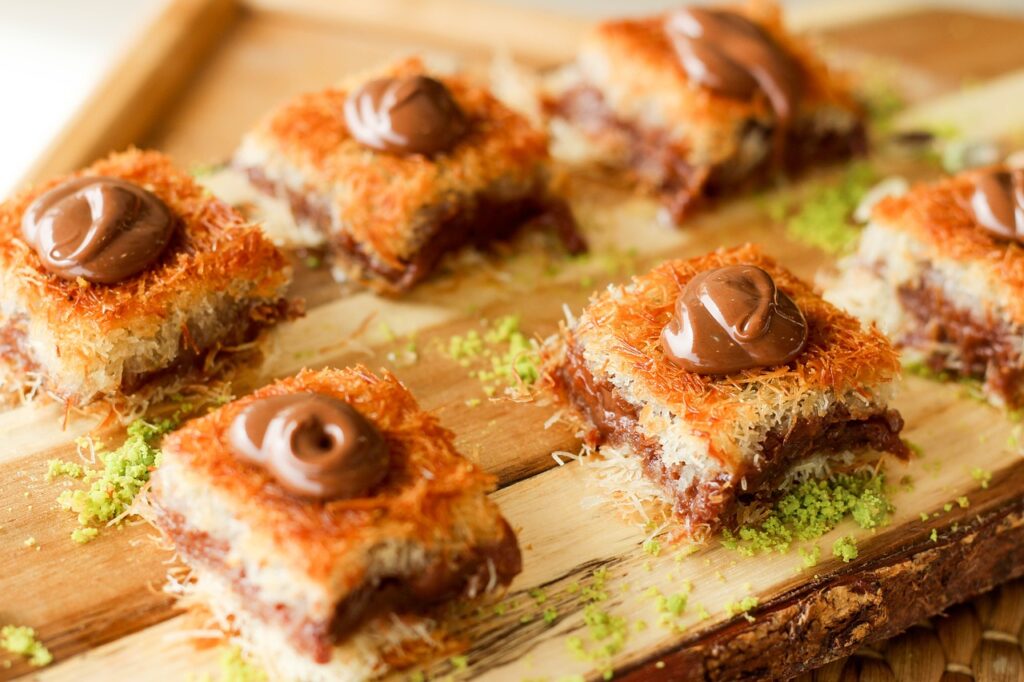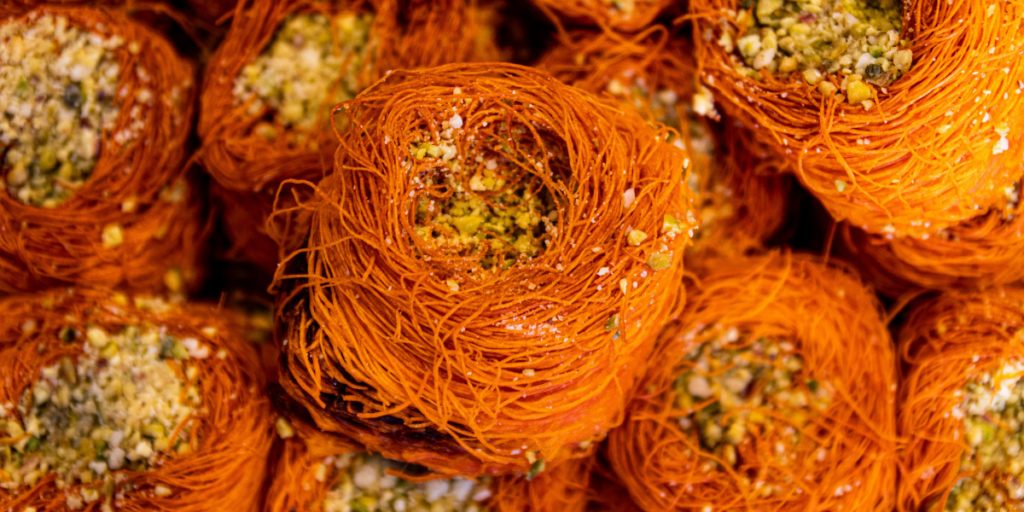Kadaif Recipe – Traditional Dessert

Wandering what is Kadaif? What is it made of, and how to prepare it?
If yes, then you’re in the right place. I’ll share everything you need to know about this recipe in this post. So make sure to keep reading, to learn all the tricks.
Let’s start with the basic question. Kadaif is a delightful dessert, known for its unique, stringy dough and sweet, nutty filling.
But before we dive into kadaif, let’s take a quick look at similar desserts to understand the differences. For instance, if you’re curious about another popular sweet treat, baklava, check out this delicious Albanian Baklava Recipe.
Or, if you’re interested in exploring more about sweet syrups and nutty flavors in desserts, the Revani Recipe is a great example.
Now let’s jump into the questions.
What Is Kadaif?

Kadaif is a sweet dessert from the Middle East and Mediterranean.
Kadaif, also known as “kataifi” or “kadayif,” originated in the Ottoman Empire, which covered regions that are now parts of Turkey, Greece, and the Middle East.
This dessert’s history is deeply intertwined with the culinary traditions of these regions, making its exact origin hard to pinpoint.
However, it’s widely recognized as a traditional dessert in both Middle Eastern and Mediterranean cuisines, reflecting the diverse influences and shared culinary heritage of the Ottoman Empire.
Each region has adapted and created variations of kadaif, making it a beloved dessert in many countries.
What Is Kadaif Made Of?
Kadaif is made of simple ingredients like pistachios, thin noodles & sugar.
This looks very simple but actually, it is a little more complicated than it looks like. So make sure to read all the steps so you won’t mess up your dessert.
Kadaif is a yummy dessert made from thin, noodle-like dough called kadaif dough. It looks a bit like shredded phyllo dough.
Inside the dough, there’s a filling of chopped nuts like pistachios, walnuts, or almonds, often mixed with a little sugar or spices.
After it’s all put together and baked, kadaif gets soaked in a sweet syrup.
This syrup is made from sugar and water and sometimes has lemon juice, rose water, or orange blossom water for extra flavor. This makes the kadaif sweet, sticky, and tasty!
What Is kadaif Dough Made Of?

Kadaif dough is made, primarily from flour, water, and a small amount of oil or butter. The secret is that you should mix these ingredients very well so that you can create a thin batter.
This batter is then expertly drizzled in thin streams onto a hot rotating plate or drum, similar to how crepes are made.
As it cooks, it solidifies into fine, thread-like strands, creating the unique, shredded texture that kadaif is known for.
How can You Prepare Kadaif?
To make kadaif, start by preheating your oven to 350°F.
Take the kadaif dough, which looks like thin, stringy noodles, and gently separate it with your fingers. Drizzle some melted butter over the dough and mix it lightly.
Next, mix chopped nuts (like walnuts or pistachios) with a bit of sugar and maybe some cinnamon. Spread half of the dough in a baking dish, add the nut mixture on top, and then cover with the rest of the dough.
Bake it until it’s golden brown. While it’s baking, make a sweet syrup by boiling sugar, water, and a bit of lemon juice. Once the kadaif is baked, pour the syrup over it and let it soak in.
Where Can You Buy Kadaif Noodles?
You can buy kadaif noodles, also known as kataifi or kadayif, from various sources, with Amazon being a convenient option. Here are some places where you can find them:
- Amazon: You can easily find kadaif noodles on Amazon and have them delivered to your doorstep. They offer a variety of brands and types to choose from.
- Middle Eastern or Mediterranean Grocery Stores: Local stores specializing in Middle Eastern or Mediterranean ingredients often carry kadaif noodles.
- International or Ethnic Markets: Larger international or ethnic markets may stock kadaif noodles in their pastry or frozen food sections.
- Local Bakeries or Dessert Shops: Some bakeries or dessert shops that specialize in Middle Eastern or Mediterranean treats may sell kadaif noodles or desserts made with kadaif.
When purchasing kadaif noodles, be sure to check the packaging for freshness and storage instructions, and select the type that best suits your recipe, whether fresh or frozen.
What Is The Difference Between Baklava and Kadaif?
Baklava and Kadaif are both sweet desserts, but they’re different in a few ways.
Baklava is made with layers of thin, flat pastry called phyllo dough, and it’s filled with chopped nuts, like pistachios or walnuts.
After baking, it’s soaked in a sweet syrup.
Kadaif, on the other hand, uses a special dough that looks like thin, stringy noodles. This dough is wrapped around the nuts, then baked and soaked in syrup just like baklava.
So, while both are nutty and sweet, baklava is more about layers and crunch, and Kadaif is unique for its stringy, noodle-like dough.
How Long Can You Keep Kadaif In Your Fridge?
Kadaif can be kept in your fridge for about 5 to 7 days.
To ensure it stays fresh, it’s important to store it properly. You should place the kadaif in an airtight container to prevent it from absorbing any odors from the fridge and to maintain its moisture level.
If it’s not stored properly, it can dry out or become too soggy.
It’s also a good idea to let it come to room temperature before serving, as this can help improve its flavor and texture after being refrigerated.
Remember, the syrup in kadaif can make it quite sticky, so careful storage is key to keeping it tasty.
Can You Freeze Kadaif?
Yes, you can freeze kadaif. Freezing is a great way to extend its shelf life while maintaining its taste and texture. To freeze kadaif:
- Cool Down: Make sure the kadaif is completely cool after baking and before freezing.
- Airtight Container: Place the kadaif in an airtight container or wrap it tightly in plastic wrap and then aluminum foil. This helps prevent freezer burn and keeps the kadaif from absorbing other flavors from the freezer.
- Label and Freeze: Label the container with the date, so you know how long it’s been in the freezer. Kadaif can be frozen for up to 3 months.
When you’re ready to eat the frozen kadaif, thaw it in the refrigerator overnight.
You might want to gently reheat it in the oven or microwave to refresh its texture and bring out its flavors.
Just be careful not to overheat it, as this can make it dry.
What are The Different Types Of kadaif?
There are several types of kadayıf (also known as kadaif or kataifi), each with its unique twist:
- Classic Kadayıf: This is the traditional version, where the shredded dough is layered or wrapped around a filling of chopped nuts (like pistachios, walnuts, or almonds), and then soaked in sweet syrup.
- Kadayıf Rolls (Saray Kadayıfı): In this variation, the kadayıf dough is rolled around a nut filling, creating small, cylindrical pastries.
- Künefe (Kanafeh): A very popular type, especially in the Levant and Turkey. It sandwiches a layer of cheese (like unsalted mozzarella or a traditional cheese like akkawi) between two layers of kadayıf dough. After baking, it’s soaked in syrup and often served warm.
- Tel Kadayıf: This is similar to classic kadayıf but uses a thicker strand of dough, giving a different texture.
- Baked Kadayıf (Fırın Kadayıfı): This is often a larger, baked version where the kadayıf dough is layered in a tray, similar to baklava, with a nut filling in between.
- Dessert Cups or Nests: The kadayıf dough is shaped into small cups or nests and baked. They are then filled with various sweet fillings, like cream, custard, or fruit.
How Can You Serve Kadaif?
Kadaif can be served in a few ways:
- Warm or at Room Temperature: It’s often served warm or at room temperature, which really brings out its flavors and makes it extra delicious.
- With Nuts: Since nuts are a key ingredient in kadaif, serving it with additional chopped nuts on top, like pistachios or walnuts, adds a nice crunch and extra flavor.
- With Syrup: Kadaif is usually sweetened with syrup, often flavored with rose water, orange blossom water, or lemon. Drizzling a little extra syrup on top when serving can make it even more mouthwatering.
- With Cream or Ice Cream: Some people like to serve kadaif with a side of fresh cream or a scoop of ice cream, especially if the kadaif is warm.
- Garnished with Fruits: A garnish of fresh fruits, like berries or slices of citrus, can add a refreshing touch and balance the sweetness.
- With a Cup of Tea or Coffee: In many cultures, kadaif is traditionally enjoyed with a cup of tea or coffee, which complements its sweet, rich flavor.
Kadaif Recipe
Ingredients
- 1 lb kadaif dough thawed if frozen
- 2 cups mixed nuts pistachios, walnuts, almonds, finely chopped
- 1 cup unsalted butter melted
- 1 tsp ground cinnamon
Instructions
- Preheat Oven & Prepare Pan: Preheat your oven to 350°F (175°C). Grease a 9×13 inch baking pan.
- Prepare Kadaif Dough: Gently separate the kadaif dough strands with your fingers. Mix the dough with melted butter until well coated.
- Add Nuts: Mix the chopped nuts with cinnamon. Spread half of the buttered kadaif dough evenly into the baking pan. Press gently. Sprinkle the nut mixture over the dough layer. Cover with the remaining kadaif dough, pressing down lightly.
- Bake: Bake in the preheated oven for about 45 minutes or until the top turns golden brown.
- Make Syrup: While the kadaif is baking, combine sugar, water, and lemon juice in a saucepan. Bring to a boil, then simmer for 10 minutes. Add rose water or orange blossom water, if using.
- Combine Kadaif and Syrup: Remove the kadaif from the oven and immediately pour the hot syrup over it. Allow it to soak in for at least 1 hour.
- Serve: Cut into pieces and serve at room temperature or slightly warmed.
Conclusion
Kadaif is a super tasty dessert from the Middle East, famous for its unique, stringy dough that looks like thin noodles.
It’s usually filled with chopped nuts like pistachios or walnuts and sweetened with yummy syrup. When baked, kadaif turns golden and crunchy, and the syrup makes it sweet and sticky.
It’s a bit like baklava but has its own special twist because of its noodle-like dough.
People often enjoy kadaif on special occasions or as a special treat, and it’s really popular in many countries. It’s a fun and delicious dessert that’s definitely worth trying!

